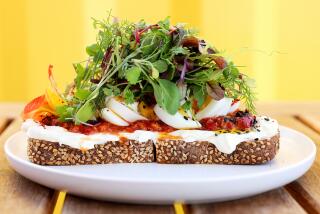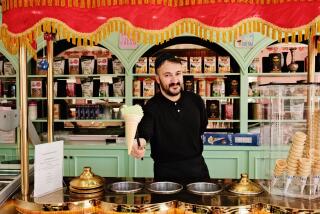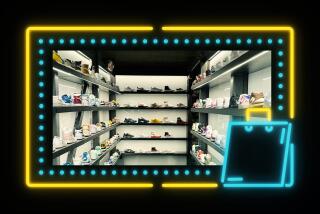Romancing Istanbul’s Bazaars : More than a decade of experience has made this writer an expert on unearthing the best deals in Turkish metropolis.
- Share via
ISTANBUL, Turkey — I first saw Istanbul with Sean Connery when I was 16 and he had hair. Stirred by raging hormones and the excitement of espionage (not to mention, Sean), I fell in love with the city as it appeared in “From Russia With Love.” James Bond pursued the Soviet’s decoder machine through Saint Sofia, the Grand Bazaar, along the Bosporus, across Yugoslavia and beyond. And I dreamed of pursuing exotic treasure in the Grand Bazaar on my own.
Those Soviets are gone now but I still find Istanbul to be the most exciting city in the world and among the best shopping deals on earth. Since 1981, I’ve gone back every November to do my Christmas shopping.
Early November is actually the best time for shopping in Istanbul. The weather is cooler, but not yet freezing. The crowds of tourists are mostly gone. Whatever inventory has not been sold during the April-October high season will likely sit on shelves until spring when the tourists return. As a result, shopkeepers are much more willing to wheel and deal, so it is easier to get a better price on everything.
Although I do shop for certain items at the famous Grand Bazaar, I actually prefer the intimacy of the Spice Bazaar, which is less expensive and less crowded yet filled with surprises. I also frequent a tony shopping area called Istiklal Street, near where many of the hotels are, but only for certain items. And that is one of the beauties of shopping in Istanbul: You can find almost anything you are looking for, if you just know where to look.
The best starting point for the Egyptian or Spice Bazaar is the arched entryway across the street from the south end of the Galata Bridge, which spans the famous Golden Horn estuary separating the old city from the newer. For jewelry and linens, the deals are generally better in the Spice Bazaar than in the huge Grand Bazaar, which suffers from higher rents. And while it is easy to become disoriented in the Grand Bazaar, it is humanly impossible to get lost in the Spice Bazaar.
At times referred to as the Egyptian Bazaar, because it was built in the 15th Century using tax revenues the Ottoman Empire collected from Egypt, the Spice Bazaar is a covered shopping area flanked to the west by a food market where most of the local people do their shopping. This is also interesting because it offers opportunity to watch the locals shopping for beautiful produce and delicacies such as fresh figs in November.
If one enters from the portal closest to the Golden Horn, jewelry shops line both sides of the passage. These jewelers offer as rich an assortment as the Grand Bazaar, but prices start lower here and can be negotiated downward. Bargaining is a must, even though the starting price quoted is generally less than retail in the United States.
Buy more than one thing and the price per item drops further. When the shopkeeper says a piece is 22-carat gold you can probably believe him because the gold content is controlled by the government. But to reassure yourself, look for the 22 stamped into the gold, which should have almost a brass tone.
Good deals include gold filigree earrings for about $25 a pair, or more elaborate earrings that are copies of archeological finds such as those discovered in Hittite tombs. I found, for example, gold medallions surrounded by rows of pearls and small beads of garnet, lapis, turquoise and jadeite. Despite the semi-precious stones, these showstoppers cost under $100 a pair (they would probably start at about $300, were they available in the United States). Gold bangles are 22-carat and are sold by weight. Thus, a narrow bangle for a small wrist costs under $100. Heavier pieces are a little more.
At the end of the main passage, the bazaar reaches the legs of its T-shape. To the right are spice sellers who sell packages of the delicious apple tea that is offered to you at many of the shops. You can also buy almonds, walnuts, pistachios and an incredible variety of dates. Or yogurt sold from the goat skin in which it was made. Or you can buy spices such as saffron in bulk from large barrels. Also to the right are perfume sellers vending flower essences. To the left you will find some rather inexpensive shops for lace, linen and embroidery. Prices for linens and lace are often surprisingly low, but don’t expect to bargain unless several items are purchased from a single shop. A box of six hand-embroidered hankies will go for about $5-$7.
After leaving the Spice Bazaar don’t forget to visit the pushcarts and booths along the outer wall. Outside the portal at the end of the southeast arm of the bazaar are street vendors and stalls with jeans, sweaters, children’s clothing, baby booties and hand-knitted socks for both adults and children. These colorful woolen socks are somewhat coarse, but great for skiing. They sell for about $2-$5 a pair, depending upon size.
Vendors in this same area sell scarves in wool and silk, warm jackets for children, snow boots, shoes and gorgeous wool sweaters. Sweaters go for around $7-$9 each. The quality is excellent and styles are available for men and women.
A couple of vendors in this area also sell handsome checker or chess boards. These are intricately inlaid with woods of different color: lemon, ebony and rosewood. Brass and camel bone (which looks like ivory but is politically correct) are also used. A large, good quality set will generally cost about $20.
After completing your shopping at the Spice Bazaar, explore the neighborhood by wandering uphill (southeast, south or southwest). You will find street vendors in all directions selling great sweaters (under $10 for wool), wool and synthetic scarves (under $5) and fleece-lined denim jackets (under $20). While the street vendors generally don’t speak English, communication is easy with a pocket calculator. (Many of the vendors have them or you can buy them in the Spice Bazaar.)
Point to the item you want and say “nekadar?” which means “how much?” Then hand them the calculator. The merchant will punch in the price in Turkish lira. Divide that number by the exchange rate to see the price in dollars. If the amount is acceptable say “evet” which means “yes” and you will have a deal. To offer less, punch in a counter offer in lira. If the vendor says “hiyer” or “yok,” it’s no go. But the vendor may lower his asking price a bit. Even without haggling, the price with street vendors is usually pretty good.
From this area, try and find address No. 21 on a street called Eminonu Marpuccular (about a city block southeast of the Spice Bazaar). There you will find a shop run by Sephardic Jews whose ancestors fled Spain in 1492 to avoid the Spanish Inquisition. This family-run business sells perfume essences. For about $5 they will put the essence of roses, violets or carnations into a small hand-painted, tulip-shaped bottle for you. One drop in bathwater and the bath is scented with roses, violets or carnations. Or mix the essence with alcohol at the ratio of 5 to 1 to make your own cologne. Visiting this shop is like stepping into the scent of a garden in overdrive. Even if you don’t buy, it’s an experience.
Also offering good value, in an area that begins about a block southwest of the Spice Bazaar, are shops selling Turkish cut crystal and other kinds of kitchenware. The shops--with their windows filled with crystal--line both sides of the street for several blocks in all directions.
Each piece of crystal is faceted to catch the light in thousands of cuts. Prices are unbelievable. A first-rate cut crystal whiskey decanter might run $37 (a comparable piece of Irish crystal purchased in the United States could cost $250). A set of six matching glasses costs under $25 (perhaps $150 in the United States). Many of the shops also sell beautiful cut glass. The Turkish word for lead crystal is kristal ; cut glass is called bardak . Not surprisingly, bardak is less expensive than crystal. A pretty cut glass bud vase or candy dish, for example, will cost under $10. Just say “kristal” or “bardak” and the shopkeepers will point you to the right part of the shop.
About a 15-minute taxi north, in the newer part of the city where the hotels are, is Istiklal Street--another major shopping district that has been compared with Rodeo Drive, especially as it approaches Taksim Square. Although this area is more exclusive than the bazaars, it features lots of good shopping of the more sophisticated type and while it is more expensive than the bazaars, it is still much less than hotel shops. It runs in a sort of L southwest from Taksim Square toward the Golden Horn.
In November, the street is festooned with Christmas decorations while carols play in the stores. There’s nothing like the culture blend of strolling through one of the greatest cities of the Muslim world while admiring Christmas decorations and listening to a recording of Bing Crosby singing “White Christmas.”
On this street (No. 214) is my favorite Istanbul shop for silk. Called Ipek (the Turkish word for silk), it has excellent prices on silk and wool scarves. Located on the west side of Istiklal, just south of the Galatasaray tram stop, Ipek sells silk scarves in turquoise, vermilion, jade or navy paisley patterns starting at $5. Higher priced items include hand-painted silk in antique Ottoman designs. The owners will invite you in to sit and have a glass of apple tea. They then will display a mind-boggling array of colors, textures and styles. Unlike street vendors, this shop takes Visa.
Perhaps a 10-minute taxi ride south of the Spice Bazaar, the Grand Bazaar is often condemned as a tourist trap but I think undeservedly so. This is the original “mall,” perhaps the largest covered market in the world, said to have 4,000 shops. On a rainy or blustery day in November you can wander the streets of the Grand Bazaar in relative comfort. Some travelers worry about getting lost in its miles of alleys and walkways. But insiders know that the Bazaar is laid out on an irregular grid on the slope of one of Istanbul’s seven hills. To find your way back to a taxi, just head uphill. The three openings at the top of the bazaar are all near taxi stands.
It is exotic, with dazzling displays of gold on the main jewelry sellers’ street. There are areas devoted to leather jackets and clothing, an antique bazaar, an oriental rug area, fabric sellers with everything from tent fabric to silks and satins in jewel colors. There are shish-kebab restaurants and fruit juice stalls for the thirsty shopper. One street is devoted to meerschaum pipes and amber cigarette holders. Even if you don’t buy a thing, it is a spectacle not to be missed.
If you enter through the eastern gate at Nuruosmaniye Mosque, you will walk through the archway onto Kalpakcilar, the main gold seller’s street. The very first jewelry store on the right (Ugur-Al at No. 2) is my favorite shop. This shop is tiny but jammed and overwhelming. There’s so much color and light and sparkle it’s easy to walk in and be overcome. While you are sipping apple tea, you must bargain for what you want. I like it because it’s a jumble of jewelry and the pieces are interesting and one-of-a-kind. Tell the merchant what you’re looking for and he will overwhelm you with variety. Prices vary but a spectacular diamond and emerald dinner ring there cost $600 . . . at least after bargaining.
Yet one of the most compelling reasons for going to the Grand Bazaar is the silversmith area. In particular, near the older part of the Bazaar are some sterling silver dealers selling very fine work at low prices. So after you leave the Ugur-Al jewelry store, turn right and walk down Kalpakcilar Street. When you reach the first intersection, turn right (north) onto Kuyumcular Street and after a few blocks downhill you will come to the oldest part of the area, called the old bazaar (Bedesten). Along the eastern perimeter of the old bazaar are the silver sellers. The pieces are sold by weight, although this is negotiable. There is some benefit to paying with U.S. currency (best), credit card or U.S. currency travelers checks.
At a place called Gumuscu (No. 5-7 Muhafacilar Sok), silver candlesticks in an ornate Russian style were about $225 apiece. A pair of ice tongs in silver was about $22, sugar tongs about $12.
A final piece of advice: There’s no need to let Istanbul’s complexity overwhelm you. Stick to my two rules of thumb for shopping: Never pay retail and never deal with strangers. If you use this guide, you won’t do either.
More to Read
Sign up for The Wild
We’ll help you find the best places to hike, bike and run, as well as the perfect silent spots for meditation and yoga.
You may occasionally receive promotional content from the Los Angeles Times.






